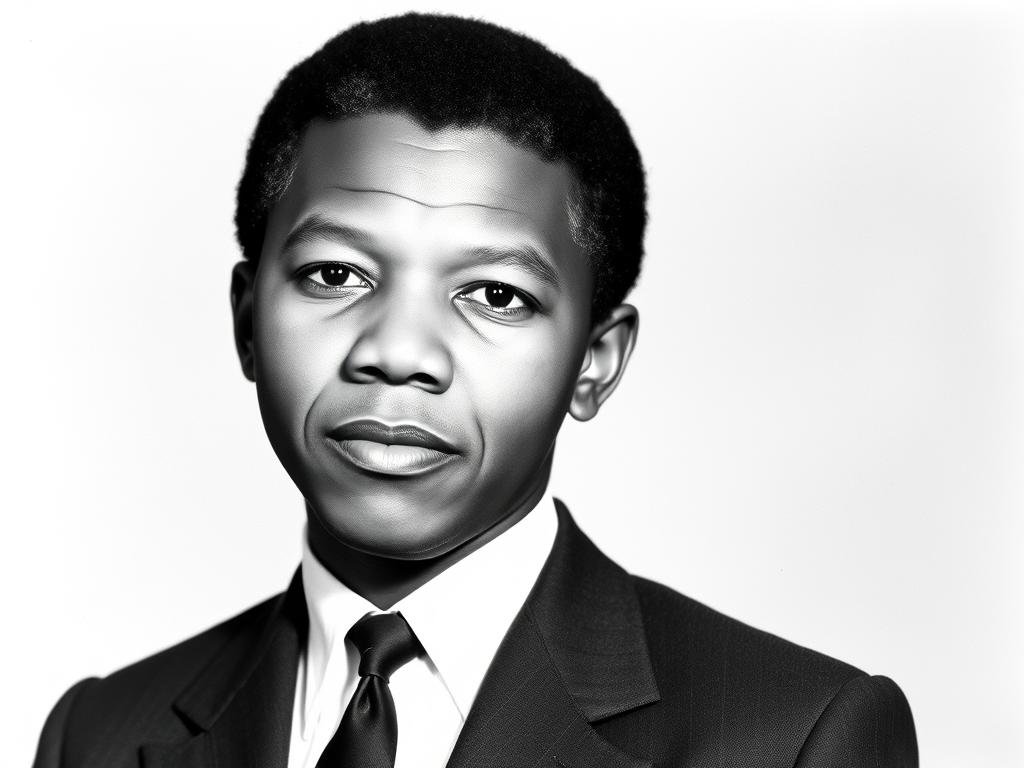Nelson Mandela’s True Story – From Prisoner to President
Few journeys in modern history capture the triumph of human spirit like Nelson Mandela’s transformation from prisoner to president. For 27 years, Mandela was confined behind bars, yet emerged to lead South Africa toward democracy and reconciliation. His path from prisoner number 466/64 on Robben Island to becoming his nation’s first Black president represents one of history’s most remarkable political transformations.
This extraordinary “Nelson Mandela prisoner to president” story continues to inspire millions worldwide. It demonstrates how unwavering principles, strategic patience, and the capacity for forgiveness can overcome seemingly insurmountable obstacles. Let’s explore the key milestones of this remarkable journey.
Early Life and Path to Activism
Nelson Mandela in his early years as an activist
Born Nelson Rolihlahla Mandela on July 18, 1918, in the small village of Mvezo, South Africa, Mandela was destined for a remarkable life. The name “Rolihlahla” translates to “pulling the branch of a tree” or colloquially, “troublemaker” – perhaps a prophetic glimpse of his future role challenging the established order.
After receiving a formal Western education, Mandela studied law at the University of Fort Hare and later at the University of Witwatersrand. These formative years shaped his understanding of the systemic injustices facing Black South Africans under the increasingly oppressive apartheid regime.
In 1944, Mandela joined the African National Congress (ANC), beginning his lifelong commitment to ending racial discrimination in South Africa. Initially advocating for nonviolent resistance inspired by Mahatma Gandhi, Mandela rose through the ranks of the ANC, becoming a prominent leader in the fight against apartheid.
Underground Resistance and Arrest
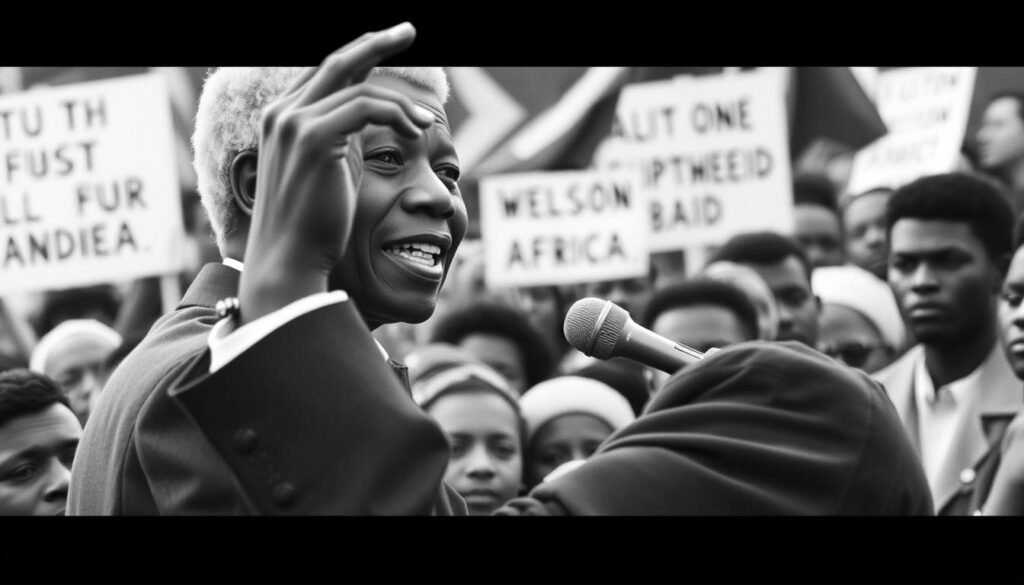
Mandela addressing supporters before going underground
By 1960, following the Sharpeville Massacre where police killed 69 peaceful protesters, the South African government banned the ANC. This watershed moment led Mandela to reconsider his nonviolent stance. He helped establish Umkhonto we Sizwe (“Spear of the Nation”), the armed wing of the ANC.
Mandela went underground in 1961, earning the nickname “The Black Pimpernel” as he evaded authorities while organizing resistance. During this period, he traveled abroad to gather support and receive military training. His activities made him the most wanted man in South Africa.
On August 5, 1962, Mandela’s underground journey came to an abrupt end when police captured him at a roadblock near Howick. Initially sentenced to five years for leaving the country illegally and inciting workers to strike, Mandela would soon face much more serious charges.
The Rivonia Trial: Prepared to Die
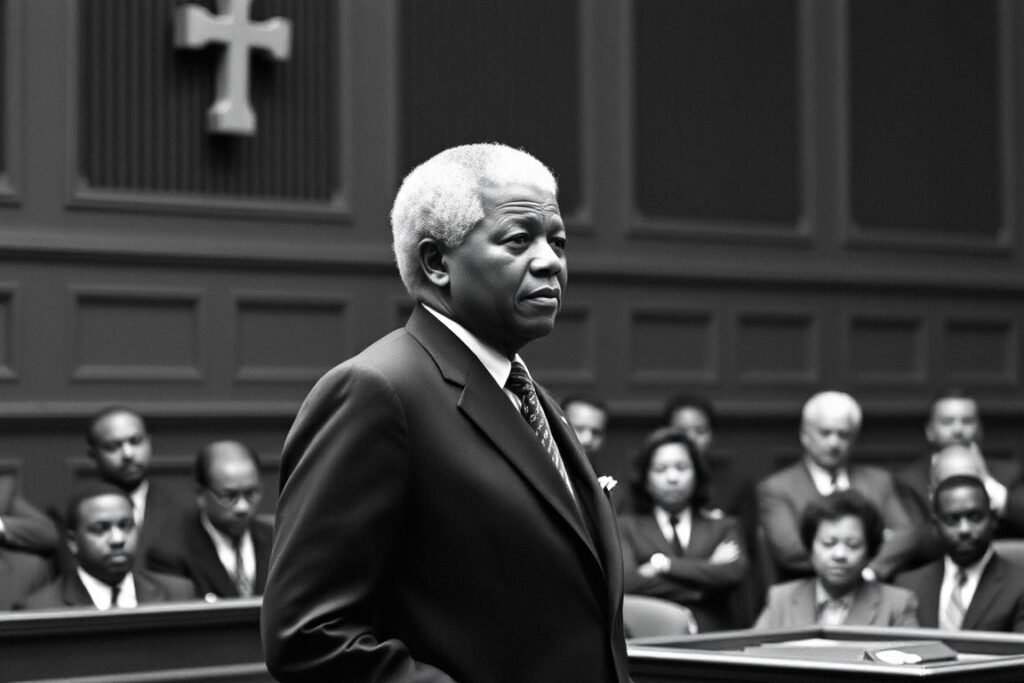
Mandela during the Rivonia Trial, 1964
While already imprisoned, Mandela and several other ANC leaders were brought to trial again in what became known as the Rivonia Trial. They faced charges of sabotage and conspiracy to overthrow the government – crimes punishable by death.
On April 20, 1964, Mandela delivered his famous “Speech from the Dock,” concluding with words that would echo through history:
“I have fought against white domination, and I have fought against black domination. I have cherished the ideal of a democratic and free society in which all persons live together in harmony and with equal opportunities. It is an ideal which I hope to live for and to achieve. But if needs be, it is an ideal for which I am prepared to die.”
On June 12, 1964, Mandela and seven others were sentenced to life imprisonment. Mandela was assigned prisoner number 466/64 and sent to the notorious Robben Island prison off the coast of Cape Town.
The Prison Years: 27 Years Behind Bars
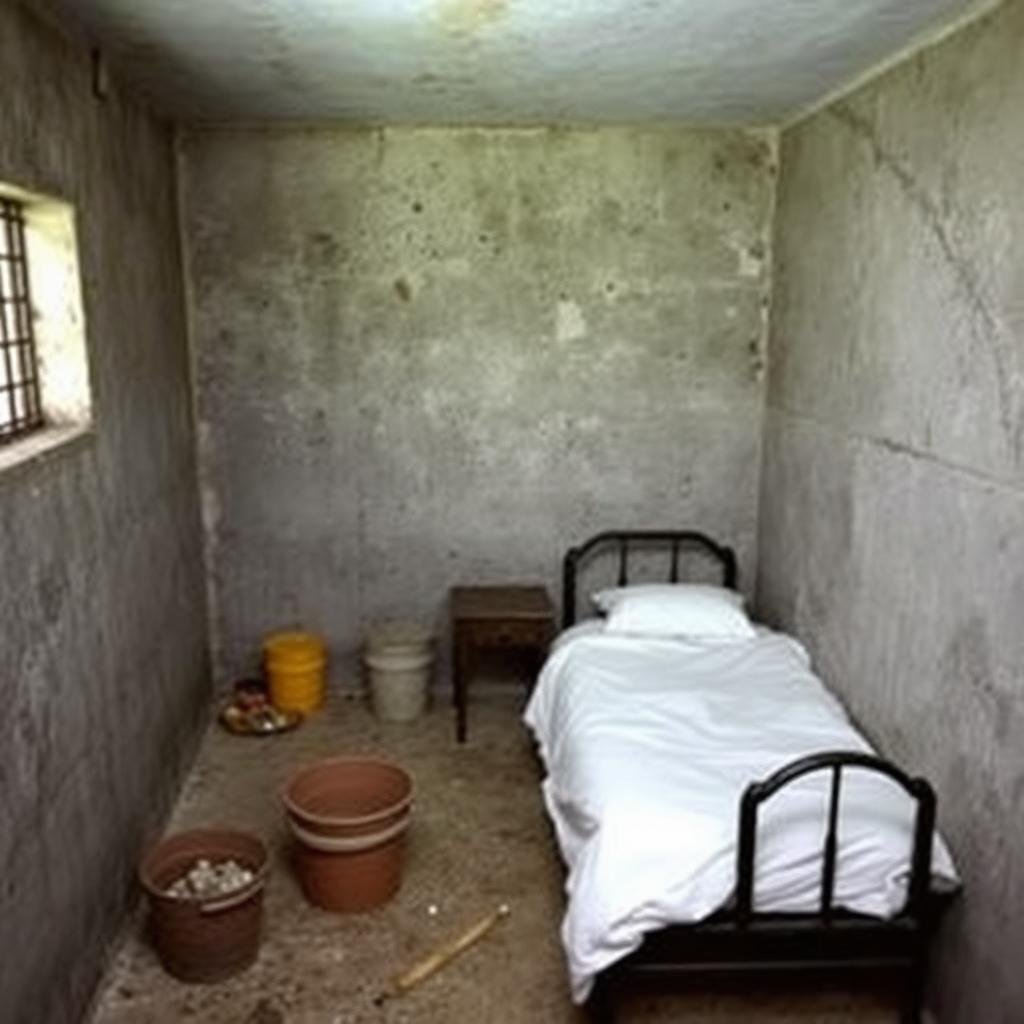
Mandela’s cell on Robben Island
Mandela’s 27-year imprisonment can be divided into three phases:
- Robben Island (1964-1982): For 18 years, Mandela endured harsh conditions in this maximum-security prison. He was forced to perform hard labor in a limestone quarry, slept on a straw mat, and was permitted only one visitor and one letter every six months.
- Pollsmoor Prison (1982-1988): Mandela was transferred to this mainland prison near Cape Town, where conditions improved slightly. Here, he began secret talks with government representatives.
- Victor Verster Prison (1988-1990): Mandela’s final place of confinement was a warder’s house on this prison farm, where he was held under minimum security conditions.
Life on Robben Island
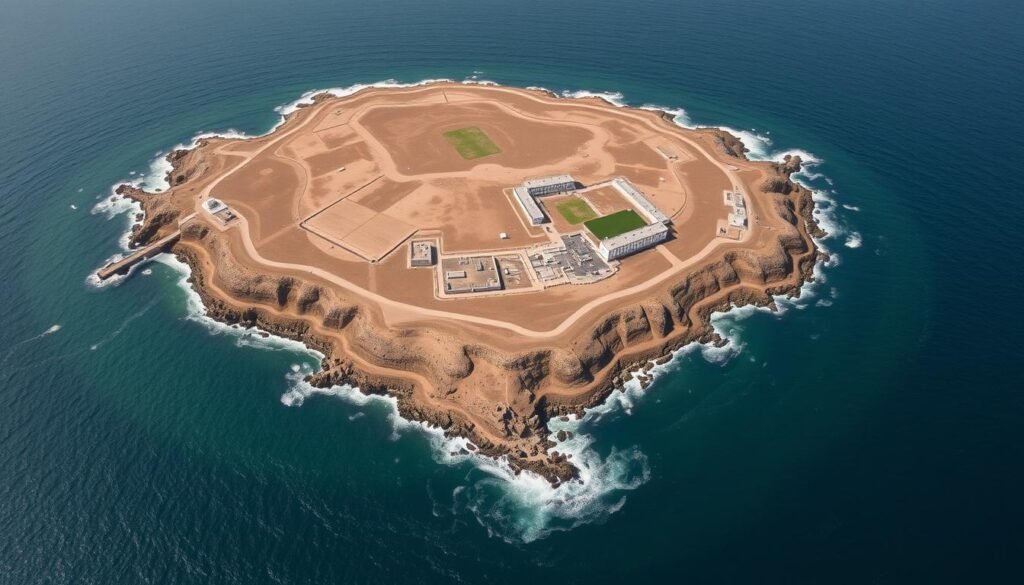
Aerial view of Robben Island prison
On Robben Island, Mandela faced calculated humiliation and hardship. As a Black prisoner, he received fewer rations than Indian or mixed-race prisoners. The work in the limestone quarry damaged his eyes and lungs. Despite these conditions, Mandela maintained his dignity and continued his education.
The prison became known as “Mandela University” because of his influence on fellow inmates. He organized political discussions and education sessions, turning the prison into a center for learning and political development. Mandela also began writing his autobiography, smuggling pages out of prison.
Personal Losses During Imprisonment
During his imprisonment, Mandela endured profound personal losses. In 1968, his mother died, and in 1969, his eldest son Thembekile was killed in a car accident. The government refused to allow Mandela to attend either funeral – a particularly cruel punishment in African culture, where funeral rites hold deep significance.
His marriage to Winnie Madikizela-Mandela, who became a powerful anti-apartheid figure in her own right, eventually deteriorated under the strain of separation and political pressures. They would divorce in 1996, after his release.
Negotiations and Path to Freedom
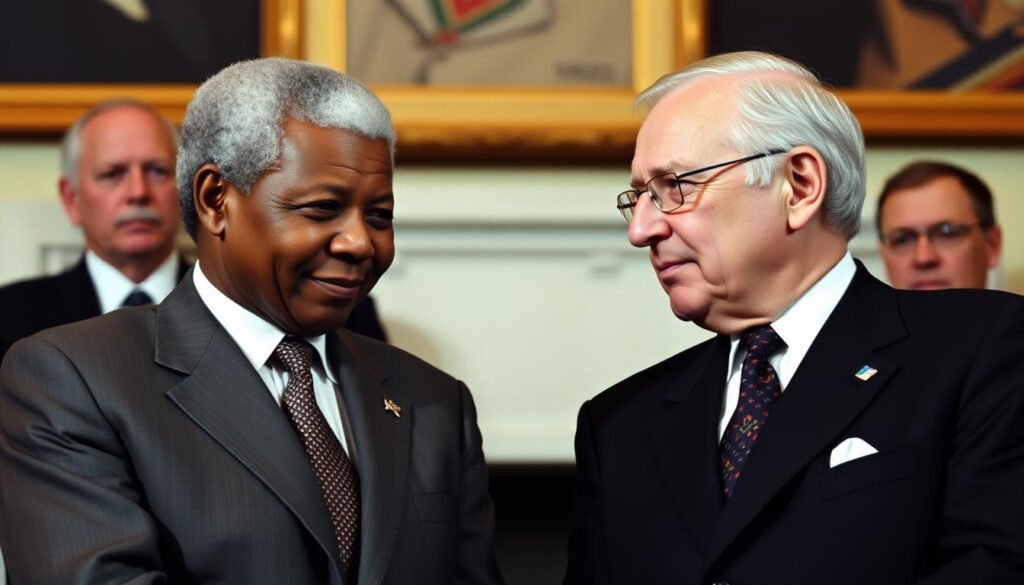
Mandela meeting with President F.W. de Klerk during negotiations
By the mid-1980s, international pressure against apartheid had intensified. Economic sanctions, cultural boycotts, and diplomatic isolation were taking their toll on South Africa. The government made conditional offers of freedom to Mandela, including a 1985 offer that required him to renounce violence.
Mandela refused, stating: “Only free men can negotiate. Prisoners cannot enter into contracts.” This principled stance further elevated his moral authority.
In 1985, Mandela initiated contact with the government, beginning a long process of negotiation. He first met with Justice Minister Kobie Coetsee in 1987 and later with President P.W. Botha in 1989. When F.W. de Klerk became president later that year, the pace of change accelerated.
On February 2, 1990, de Klerk announced the unbanning of the ANC and other political organizations. Nine days later, on February 11, 1990, Nelson Mandela walked free after 27 years in prison.
From Release to Presidency
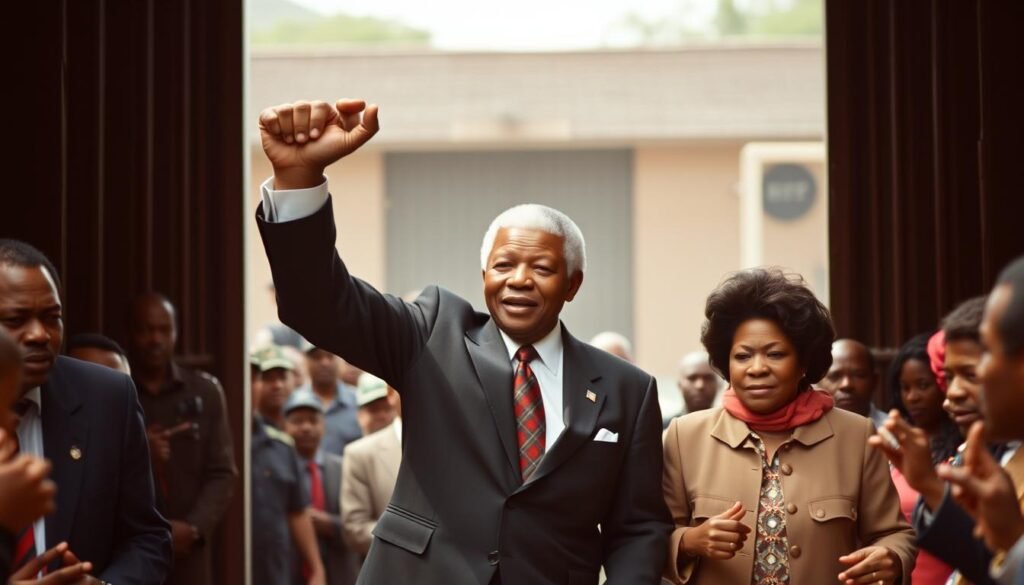
Mandela’s triumphant walk to freedom, February 11, 1990
Upon his release, Mandela addressed a massive crowd from the balcony of Cape Town’s City Hall, declaring his commitment to peace and reconciliation: “I stand here before you not as a prophet, but as a humble servant of you, the people.”
The four years between Mandela’s release and his presidency were filled with intense negotiations, violence, and uncertainty. As deputy president of the now-legal ANC, Mandela led negotiations with the de Klerk government to dismantle apartheid and establish a multiracial democracy.
These negotiations were not without challenges. Political violence claimed thousands of lives, and the process nearly collapsed several times. Throughout this period, Mandela’s steady leadership and commitment to peaceful transition prevented South Africa from descending into civil war.
The 1994 Election: South Africa’s New Beginning
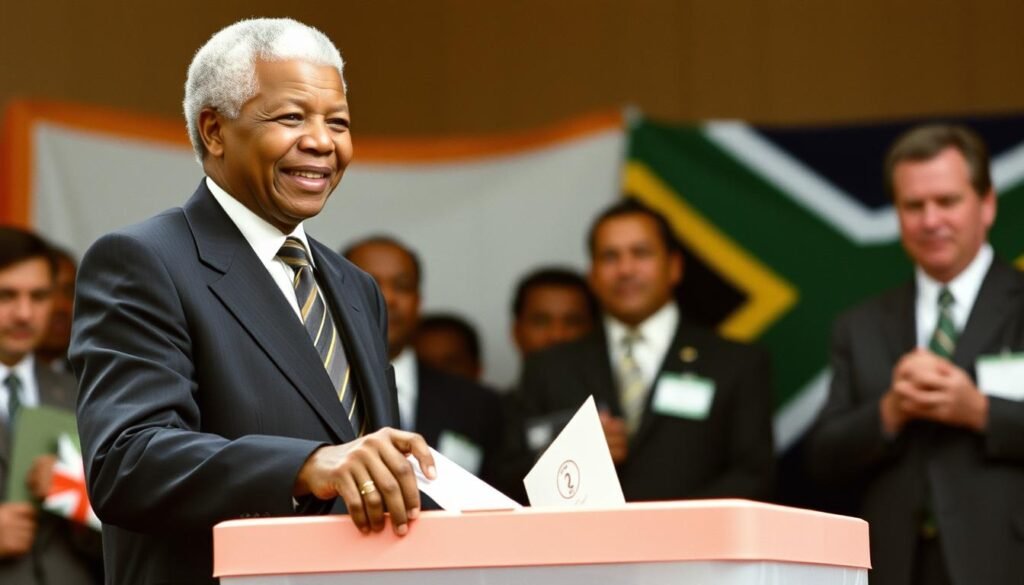
Mandela voting in South Africa’s first democratic election, April 27, 1994
On April 27, 1994, South Africa held its first democratic election with universal suffrage. Millions of South Africans of all races stood in long lines to cast their votes – many for the first time in their lives. The ANC won a decisive victory, and on May 10, 1994, Nelson Mandela was inaugurated as South Africa’s first Black president.
In his inaugural address, Mandela captured the historic significance of the moment:
“Never, never and never again shall it be that this beautiful land will again experience the oppression of one by another… The sun shall never set on so glorious a human achievement.”
Presidency and Lasting Legacy
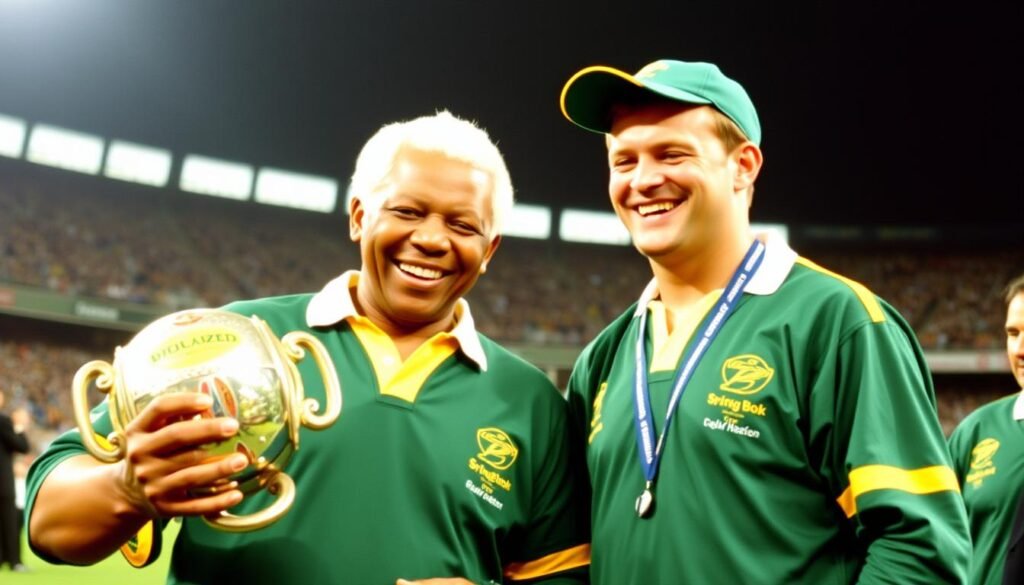
President Mandela presenting the Rugby World Cup trophy in 1995, a powerful symbol of national reconciliation
As president, Mandela focused on national reconciliation. He established the Truth and Reconciliation Commission, led by Archbishop Desmond Tutu, to address human rights violations under apartheid. Rather than seeking vengeance, the commission aimed to heal through truth-telling and, where appropriate, amnesty.
Mandela’s embrace of the predominantly white South African rugby team during the 1995 Rugby World Cup became a powerful symbol of his vision for a unified “Rainbow Nation.” When he donned the Springbok jersey – once a hated symbol of apartheid – to present the trophy to the team’s captain, it represented a transformative moment in South African race relations.
After serving one term as president, Mandela stepped down in 1999, setting an important precedent for democratic transition of power in Africa. In his retirement, he remained active in humanitarian causes, particularly in the fight against HIV/AIDS and in promoting children’s rights through his Nelson Mandela Foundation.
Nelson Mandela passed away on December 5, 2013, at the age of 95. His funeral was attended by nearly 100 heads of state and thousands of mourners from around the world, a testament to his global impact.
Lessons from Mandela’s Journey: Prisoner to President
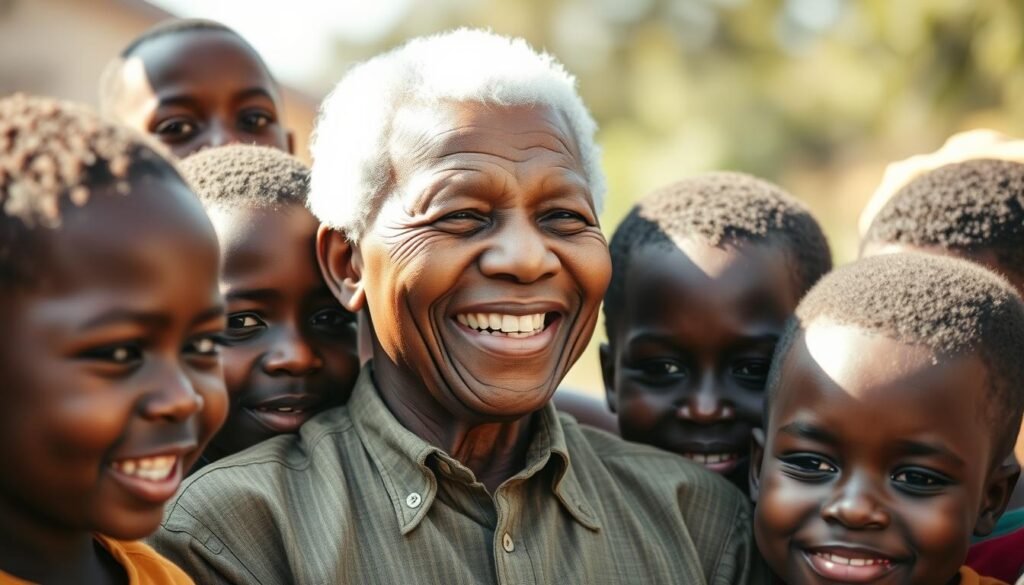
Mandela with South Africa’s future generation
The “Nelson Mandela prisoner to president” journey offers timeless lessons that transcend borders and generations:
Resilience
Mandela’s 27 years in prison demonstrated extraordinary perseverance. Rather than being broken by confinement, he used it as a time for growth, education, and strategic thinking.
Forgiveness
Instead of seeking revenge against his former oppressors, Mandela chose reconciliation. This moral courage prevented a cycle of violence and created space for healing.
Principled Leadership
Throughout his life, Mandela maintained his core values while being tactically flexible. He understood when to stand firm and when to compromise for the greater good.
Conclusion: The Enduring Impact of Mandela’s Journey
The transformation of Nelson Mandela from prisoner to president represents one of history’s most inspiring narratives of personal and political triumph. His journey demonstrates how a single individual’s moral courage, strategic patience, and capacity for forgiveness can change the course of a nation.
Today, while South Africa continues to face significant challenges, Mandela’s vision of a unified, democratic “Rainbow Nation” remains a powerful ideal. His example continues to inspire freedom movements and reconciliation efforts worldwide.
The “Nelson Mandela prisoner to president” story reminds us that even the most entrenched systems of oppression can be dismantled through persistent, principled resistance and a willingness to envision a more just future.
Deepen Your Understanding of Nelson Mandela’s Legacy
Explore how Mandela’s principles of resilience, forgiveness, and reconciliation can be applied to today’s challenges. Download our free guide “Mandela’s Wisdom: Timeless Lessons for Modern Leadership.”

